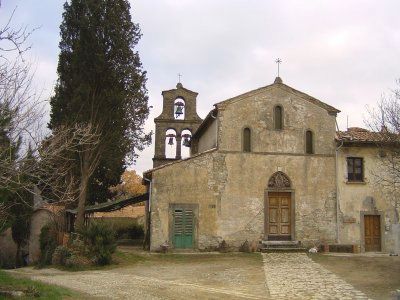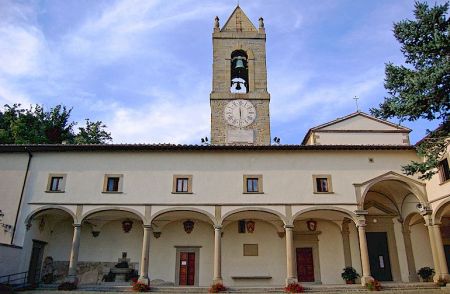Churches of Pontassieve

Chiesa di Santa Maria in Acone
Chiesa di Sant'Eustachio ad Acone, also known as Sant'Eustachio in Jerusalem, used to be the mother church of the vast Acone parish.
Chiesa di Santa Maria ad Acone dates to 925 and among its protectors were the Donati family and the San Matteo Hospital in Florence. The present structure was built in the year 1100, and restored more than once since then, this church nevertheless conserves many aspects of its Romanesque design. The interior has an apse portraying Our Lady of the Assumption with Angels and Cherubs and other decorative works by Leto and Galileo Chini. Additionally, there are two other important paintings, the Virgin Enthroned surrounded by saints (attributed to Ghirlandaio), and the Madonna del Carmine.
Chiesa di Sant'Andrea a Doccia was mentioned for the first time in 1024 in a document, now in the Vatican, by Bishop Hildebrand. It is referred to as belonging to the monastery of San Miniato al Monte. It has been rebuilt numerous times. The interior has the following features: a tabernacle (attributed to Robbiano), depicting St. Bernardino of Siena with St Catherine of Alessandria; a portrait of the Virgin and Child and Saints from 1503, attributed to Ghirlandaio, a portrait of the Crucifixion and the Saints, painted in 1776 by Ignazio Hughford, and a canvas of the Crucifixion that is a copy of Rembrandt’s work.
Pieve di San Giovanni a Rèmole dates from 955 and was head of a parish extending on both sides of the Arno river. Although restored as recently as 1950, this church still displays a multitude of Romanesque features. Inside, there are three naves, and, under the presbytery, there is a space dedicated to relics. Some of the other historical treasures on show are the remains of some frescoes and two tablets from the 14 C, both by Botticelli - one depicting the Virgin Enthroned surrounded by Angels and Saints , the other the Crucifixion between the Virgin and St. John.
Pieve dei Santi Gervasio e Martino a Lobaco is an 11 C church dedicated to San Gervasio and located in Alpiniano.
Chiesa di Santa Maria ad Acone dates to 925 and among its protectors were the Donati family and the San Matteo Hospital in Florence. The present structure was built in the year 1100, and restored more than once since then, this church nevertheless conserves many aspects of its Romanesque design. The interior has an apse portraying Our Lady of the Assumption with Angels and Cherubs and other decorative works by Leto and Galileo Chini. Additionally, there are two other important paintings, the Virgin Enthroned surrounded by saints (attributed to Ghirlandaio), and the Madonna del Carmine.
Chiesa di Sant'Andrea a Doccia was mentioned for the first time in 1024 in a document, now in the Vatican, by Bishop Hildebrand. It is referred to as belonging to the monastery of San Miniato al Monte. It has been rebuilt numerous times. The interior has the following features: a tabernacle (attributed to Robbiano), depicting St. Bernardino of Siena with St Catherine of Alessandria; a portrait of the Virgin and Child and Saints from 1503, attributed to Ghirlandaio, a portrait of the Crucifixion and the Saints, painted in 1776 by Ignazio Hughford, and a canvas of the Crucifixion that is a copy of Rembrandt’s work.
Pieve di San Giovanni a Rèmole dates from 955 and was head of a parish extending on both sides of the Arno river. Although restored as recently as 1950, this church still displays a multitude of Romanesque features. Inside, there are three naves, and, under the presbytery, there is a space dedicated to relics. Some of the other historical treasures on show are the remains of some frescoes and two tablets from the 14 C, both by Botticelli - one depicting the Virgin Enthroned surrounded by Angels and Saints , the other the Crucifixion between the Virgin and St. John.
Pieve dei Santi Gervasio e Martino a Lobaco is an 11 C church dedicated to San Gervasio and located in Alpiniano.
Santuario della Madonna delle Grazie is also know as "Madonna del Sasso" because of a series of apparitions of the Virgin Mary that occurred in 1484. The church was constructed in 1490, replacing a mediaeval oratory.
Chiesa di San Martino a Molin del Piano was first documented in the 13 C and was under the patronage of the bishop of Fiesole and the Saltarelli family.
Pieve di San Lorenzo a Montefiesole has existed since 1190 but was transformed into parish church in 1461. It is situated next to the ruins of the castle belonging to the Bishop of Florence.
Prepositura di San Michele Arcangelo was known as the Church of Sant'Angelo a Sieve until the 17 C when it took the name of San Michele. It was first documened at the beginning of the 13 C. It was completely rebuilt in the 18 C and was re-consecrated in 1788.
Chiesa dei Santi Martino e Giusto a Quona was originally dedicated to San Martino but was later called San Giusto after the first church was demolished.
Chiesa di Santa Brigida is said to have been constructed on the site of a cave used by Saint Brigida for meditation in 10 C. The church was enlarged during the 16 C and 17 C and restored in modern times.
Chiesa di San Giovanni Battista a Monteloro was first documented in 1102. It is located next to the ruins of the castle of the same name.
Chiesa di San Martino a Molin del Piano was first documented in the 13 C and was under the patronage of the bishop of Fiesole and the Saltarelli family.
Pieve di San Lorenzo a Montefiesole has existed since 1190 but was transformed into parish church in 1461. It is situated next to the ruins of the castle belonging to the Bishop of Florence.
Prepositura di San Michele Arcangelo was known as the Church of Sant'Angelo a Sieve until the 17 C when it took the name of San Michele. It was first documened at the beginning of the 13 C. It was completely rebuilt in the 18 C and was re-consecrated in 1788.
Chiesa dei Santi Martino e Giusto a Quona was originally dedicated to San Martino but was later called San Giusto after the first church was demolished.
Chiesa di Santa Brigida is said to have been constructed on the site of a cave used by Saint Brigida for meditation in 10 C. The church was enlarged during the 16 C and 17 C and restored in modern times.
Chiesa di San Giovanni Battista a Monteloro was first documented in 1102. It is located next to the ruins of the castle of the same name.

